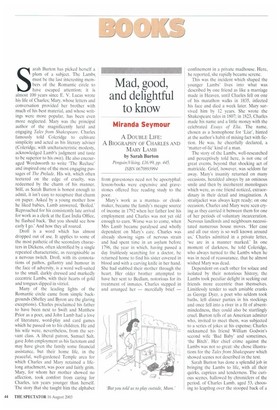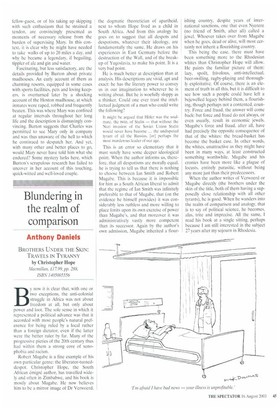Mad, good, and delightful to know
Miranda Seymour
A DOUBLE LIFE: A BIOGRAPHY OF CHARLES AND MARY LAMB by Sarah Burton Penguin/Viking, £16.99, pp. 445, ISBN 0670893994 Sarah Burton has picked herself a plum of a subject. The Lambs, must be the last interesting members of the Romantic circle to have escaped attention; it is almost 100 years since E. V. Lucas wrote his life of Charles; Mary, whose letters and conversation provided her brother with much of his best material, and whose writings were more popular, has been even more neglected. Mary was the principal author of the magnificently lurid and engaging Tales from Shakespeare. Charles famously told Coleridge to cultivate simplicity and acted as his literary adviser (Coleridge, with uncharacteristic modesty, acknowledged Lamb's judgment and taste to be superior to his own). He also encouraged Wordsworth to write The Recluse' and inspired one of the most engaging passages of The Prelude. His wit, which often teetered on the edge of cruelty, was redeemed by the charm of his manner. Still, as Sarah Burton is honest enough to admit, it isn't easy to recapture that charm on paper. Asked by a young mother how he liked babies, Lamb answered, 'Boiled.' Reproached for his consistently late arrival for work as a clerk at the East India Office, he flashed back, 'But you should see how early I go.' And how they all roared. Droll is a word which has almost dropped out of use. It applies to some of the most pathetic of the secondary characters in Dickens, often identified by a single repeated characteristic, as recognisable as a nervous twitch. Droll, with its connotations of pathos, gallantry and humour in the face of adversity, is a word well-suited to the small, darkly dressed and markedly eccentric Lambs, with their hearts of gold and tongues dipped in vitriol.
Many of the leading lights of the Romantic circle came from simple backgrounds (Shelley and Byron are the glaring exceptions). Charles proclaimed his father to have been next to Swift and Matthew Prior as a poet, and John Lamb had a love of literature, word-play and card games which he passed on to his children. He and his wife were, nevertheless, from the servant class. A liberal patron, Samuel Salt, gave John employment as his factotum and may have given the family some financial assistance, but their home life, in the peaceful, well-gardened Temple area for which Charles and Mary retained a lifelong attachment, was poor and fairly grim. Mary, for whom her mother showed no affection, took comfort from caring for Charles, ten years younger than herself, The story that she taught him the alphabet from gravestones need not be apocryphal: lesson-books were expensive and gravestones offered free reading study to the poor.
Mary's work as a mantuaor cloakmaker, became the family's meagre source of income in 1792 when her father lost his employment and Charles was not yet old enough to earn. Worse was to come, when Mrs Lamb became paralysed and wholly dependent on Mary's care. Charles was already showing signs of nervous strain and had spent time in an asylum before 1796, the year in which, having passed a day fruitlessly searching for a doctor, he returned home to find his sister covered in blood and with a carving knife in her hand. She had stabbed their mother through the heart. Her older brother attempted to have her sent to Bedlam, notorious for its treatment of inmates. Charles stepped in and arranged her — mercifully brief
confinement in a private madhouse. Here, he reported, she rapidly became serene. This was the incident which shaped the younger Lambs' lives into what was described by one friend as like a marriage made in Heaven. until Charles fell on one of his marathon walks in 1835. infected his face and died a week later. Mary survived him by 12 years. She wrote the Shakespeare tales in 1807; in 1823, Charles made his name and a little money with the celebrated Essays of Ella. The name, chosen as a homophone for 'Liar', hinted at the author's habit of mixing fact with fiction. He was, he cheerfully declared, a 'matter-of-lie' kind of a man.
The story of the Lambs, well-researched and perceptively told here, is not one of great events, beyond that shocking act of matricide. Grief, however, was seldom far away. Mary's insanity returned on many occasions, heralded always by an ominous smile and then by incoherent monologues which were, as one friend noticed, extraordinary in their detail and imagination. A straitjacket was always kept ready; on one occasion, Charles and Mary were seen crying as they carried it between them for one of her periods of voluntary incarceration. Nervous landlords and neighbours necessitated numerous house moves. 'Her case and all our story is so well known around us,' Charles admitted in a private letter, 'we are in a manner marked.' In one moment of darkness, he told Coleridge, who always turned to the Lambs when he was in need of reassurance, that he almost wished Mary was dead. Dependent on each other for solace and isolated by their notorious history, the Lambs took peculiar delight in seeking out friends more eccentric than themselves. Limitlessly tender to such amiable cranks as George Dyer, a poet who seldom took baths, left dinner parties in his stockings and once fell into a river in a fit of absentmindedness, they could also be startlingly cruel. Burton tells of an American admirer who, invited to meet them, was subjected to a series of jokes at his expense; Charles nicknamed his friend William Godwin's second wife 'Bad Baby' and sometimes, 'the Bitch'. Her chief crime against the Lambs was not so great: she chose illustrations for the Tales from Shakespeare which showed scenes not described in the text.
Sarah Burton has done a splendid job in bringing the Lambs to life, with all their quirks, caprices and tenderness. The curious scenes, hallowed by chroniclers of the period. of Charles Lamb. aged 53, choosing to leapfrog over the stooped back of a fellow-guest, or of his taking up skipping with such enthusiasm that he strained a tendon, are convincingly presented as moments of necessary release from the burden of supervising Maly In this context, it is clear why he might have needed to take walks of up to 20 miles a day, and why he became a legendary, if beguiling, tippler of ale and gin and water.
Fascinating, but less satisfactory, are the details provided by Burton about private madhouses. An early account of them as charming resorts, equipped in some cases with sports facilities, pets and loving keepers, is overturned later by a shocking account of the Hoxton madhouse, at which inmates were raped, robbed and frequently beaten. This was where Mary was confined at regular intervals throughout her long life and the description is dismayingly convincing. Burton suggests that Charles was permitted to see Mary only in company and was thus unaware of the hell to which he continued to despatch her. And yet, with many other and better places to go, would Mary never have told him what she endured? Some mystery lurks here, which Burton's scrupulous research has failed to uncover in her account of this touching, quick-witted and well-loved couple.











































































 Previous page
Previous page